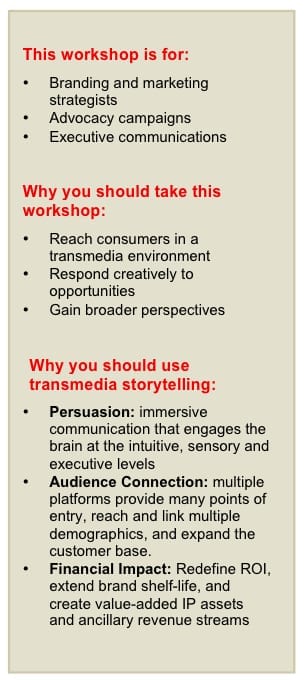 This is the standard workshop. Workshops and presentations can be customized to meet the specific needs of a company or organization.
This is the standard workshop. Workshops and presentations can be customized to meet the specific needs of a company or organization.
Rewiring communication for a transmedia world
The problem: How do you rise above the noise?
Every day you wake up to a flow of information. Your alarm clock sounds and you check your smart phone for email and Facebook posts. You scan a newspaper over breakfast; listen to the radio as you head to work. You get a warning about local traffic from your navigation device and have it search for the nearest coffee bar on the detour. Your assistant sends a text message saying that your first meeting has been delayed. Your day has only just started, you haven’t even sat down at a computer and there is already a constant conversation. It’s the same for your customer.
We live in a socially-networked, transmedia world. The wealth of information across so many channels is both an opportunity and a challenge. We need effective organizing systems and filters that connect information in the world with things that have meaning and relevance in order to break through and be heard, as individuals, organizations, and as brands.
The solution: Transmedia storytelling
Transmedia storytelling is quickly becoming the new standard for 21st century communication. Transmedia storytelling uses the tools of the storyteller—emotion, engagement, universal themes, personal connection, and relevance—to create a communication experience instead of a message. It moves the brand from slogan to interaction between the company and the customer. It unites executives with focused goals and a common purpose.
The reason: Storytelling speaks to all levels of the brain
Stories are the brain’s way of organizing information – in other words, how we rise above the noise. Stories package information for rapid comprehension by engaging the brain at all levels: intuitive, emotional, rational, and somatic.
Traditional marketing approaches no longer work. The social web has created a new consumer psychology. Consumers expect you to earn their attention with communications that are responsive, interactive, personal, and, above all, honest. Organizations must communicate in a way that treats the audience with respect and delivers value. A story can communicate who you are and inspire people at a higher level with your passion, purpose, and commitment to the customer’s experience. It is not about selling, it’s about engaging. Engaging individuals moves pre-customers to brand advocates.
Internally, the process of developing a company’s story reveals internal inconsistencies and allows executives to focus goals and create a cohesive culture.
The definition: A coherent story that unfolds across multiple platforms
Transmedia storytelling uses multiple media platforms to tell a single, coherent story or narrative that unfolds across time. Each media piece—whether it’s a website, novel, video games, mobile apps, or a film—provides different points of access and can engage different demographics. The media components add to the story while functioning as a standalone experience. The story can be experienced and appreciated at any stage, but the cumulative effect of all the pieces makes a larger, richer and more engaging message experience.
Transmedia storytelling has four fundamental parts: 1) the historical, cultural, psychological and neurological qualities of stories; 2) the psychological and technological change driving the converging media landscape; 3) story structure and the development of an authentic and coherent story; and 4) matching the story and audience with the most effective media platforms.
Transmedia Storytelling Workshop:
Neuroscience Meets Ancient Practices
A Think Lab’s Transmedia Storytelling: Neuroscience Meets Ancient Practices workshop is organized around four segments: 1) Brain and Story, 2) Narrative Tool Kit, 3) Transmedia Storytelling, and 4) Developing the Company Story.
The workshop is interactive. We include experiential exercises in our content delivery so participants can understand more deeply the aspects of story and communication. This is applicable to internal and external communications. Case studies are included to illustrate brand and advocacy story and transmedia campaigns.
This workshop can be delivered in one and two-day formats. The two-day workshop helps participants to develop their own company or personal story.
Workshop Content
Section 1: The Brain and Story. This section explains the neurological, psychological and biological underpinnings of story. Narrative is discussed from the perspectives of cognitive and social psychology. We will describe how to apply neuroscience and brain functioning to effective media and story development. Case study examples will explore popular story and myths and how they influence behavioral change.
Section 2: Narrative Tool Kit. This section covers story form, including narrative structures, components and storytelling conventions. The experiential nature of narrative will be demonstrated through a series of interactive exercises. Case studies illustrate how story can be applied to brands.
Section 3: Transmedia Storytelling. The third section of the workshop focuses on bringing together the elements to clearly define and dissect transmedia storytelling. We will cover definitions, media convergence, new media expectations, participatory culture, and psychological impact. Traditional messaging and transmedia messaging will be contrasted, and audience-media-demographic fit will be discussed. Participants will learn how to approach development of a Transmedia Storytelling campaign. Case studies will be used to illustrate aspects of transmedia storytelling campaigns and for comparing strategic blueprints.
Section 4: Finding Your Company Story. The final section of the workshop focuses on finding your company story. Participants will have the opportunity to develop their own company or personal story. Examples will be discussed as a group. Transmedia storytelling strategies will be developed based on the story concept and target audience.
Participant Gains
- Identify your authentic company or personal story
- Evaluate a transmedia story from the dual perspectives of company and audience
- Develop a transmedia storytelling campaign
- Change the way you see
pamelarutledge [at] gmail.com